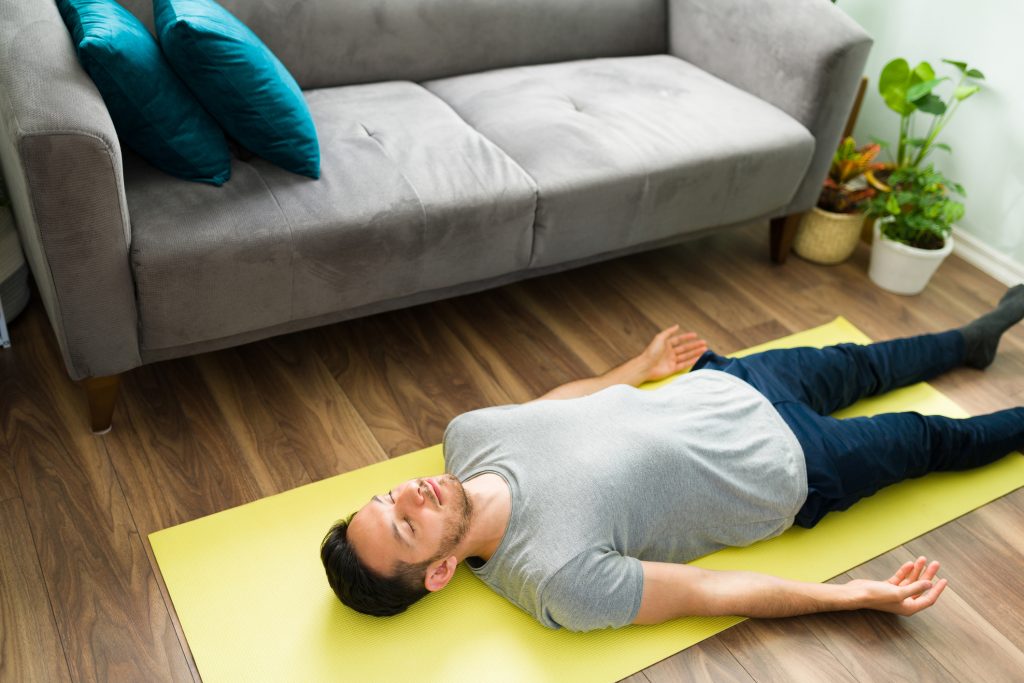By the Duke Integrative Medicine Programs Team
As we go about the activities of our day, it is often the case that we may not notice the tension in our muscles and the feelings in our bodies. With increased awareness, we can both notice and choose to relax those muscles that tend to hold habitual tension and stress.

Progressive muscle relaxation (PMR) is a deep relaxation technique used to control stress and anxiety,1–2 help with sleep disturbances (fatigue and insomnia),3 and reduce symptoms of certain types of chronic pain.3,4
Progressive muscle relaxation may be done in either a seated or lying position. Pillows or mats may be beneficial if you choose to lie down.
Progressive Muscle Relaxation is a process in which systematically tensing and releasing your muscles enhances your ability to relax. It is an opportunity to become more aware of how we hold tension in our bodies that can lead to chronic pain or discomfort. You will move through the different muscle groups of your body and, by tightening and releasing, will be able to consciously bring more relaxation to each part.
You can tighten and hold that tension for about 5 seconds, then relax and let it go. Holding your breath when you tighten your muscles and exhaling as you release them can be helpful. Be careful to tighten just enough to notice that the muscles are active and engaged, but not enough to be painful. We will be tightening and then relaxing each set of muscles twice.
If you feel comfortable closing your eyes, go ahead and allow them to close now. If you’d rather leave them open, just hold a light, gentle gaze on a point about 3 to 5 feet in front of you. You’ll now move into tensing and relaxing the muscles throughout the body.
Tense your facial muscles by squinting your eyes, wrinkling your nose, bringing the corners of your mouth towards your ears, and tensing your jaw.
Just letting the muscles go soft. Noticing what it feels like as these muscles become more and more relaxed.
• Neck
• Shoulders
• Back
• Chest
• Abdomen
• Arms and hands
• Legs and feet
• Whole body
Copyright © 2017 Duke Integrative Medicine | MIND-BODY TOOLKIT
REFERENCES
1. de Lorent L, Agorastos A, Yassouridis A, Kellner M, Muhtz C. Auricular Acupuncture Versus Progressive Muscle Relaxation in Patients with Anxiety Disorders or Major Depressive Disorder: A Prospective Parallel Group Clinical Trial. J Acupunct Meridian Stud. 2016;9(4):191-199.
2. Manzoni GM, Pagnini F, Castelnuovo G, Molinari E. Relaxation training for anxiety: a ten-years systematic review with meta-analysis. BMC Psychiatry. 2008;8:41.
3. Charalambous A, Giannakopoulou M, Bozas E, Marcou Y, Kitsios P, Paikousis L. Guided Imagery And Progressive Muscle Relaxation as a Cluster of Symptoms Management Intervention in Patients Receiving Chemotherapy: A Randomized Control Trial. PLoS ONE. 2016;11(6).
4. Akmese ZB, Oran NT. Effects of Progressive Muscle Relaxation Exercises Accompanied by Music on Low Back Pain and Quality of Life During Pregnancy. Journal of midwifery & women’s health. 2014;59(5):503-509.
Our programs and workshops help you develop skills that maximize your mind, body, and spiritual health. They’re open to adults of all ages, ranging from a one-time seminar to weekly classes and multi-day workshops. As a participant, you’ll have access to our online learning system, which houses your learning and course materials, receipts, and certificates of completion.
In our fast-paced world, stress is an inevitable part of life. Whether it's work deadlines, personal obligations, or unexpected challenges, we all face moments of anxiety. However, managing anxiety is crucial for our mental and physical well-being. Fortunately, several mind-body techniques can help us navigate stressful situations more efficiently and ...
READ MOREEmbarking on a journey towards better health is commendable, but connecting your health goals to a broader health vision becomes even more powerful. Your health vision serves as a guiding light, a roadmap that helps you navigate the complexities of daily choices and setbacks. In this blog post, we'll explore ...
READ MOREWhat Is a Sauna? A sauna is a small room or space that produces heat, typically using hot rocks, steam, or infrared heaters. The temperature inside a sauna can range from 150°F to over 200°F. People sit or lie in a sauna to enjoy its therapeutic effects, including sweating and relaxation. ...
READ MORE